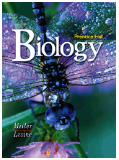BIOLOGY
by Miller & Levine
[complete Table of Contents]

|
Use the pull-down menu to jump to any of the Book's 40 Chapters: |
Additional Resources:
In this chapter, students will read about the adaptations and evolution of mammals and the major living groups of mammals. They will also read in more detail about the evolution and characteristics of the primates, with an emphasis on the evolution of humans. The links below lead to additional resources to help you with this chapter. These include Hot Links to Web sites related to the topics in this chapter, the Take It to the Net activities referred to in your textbook, a Self-Test you can use to test your knowledge of this chapter, and Teaching Links that instructors may find useful for their students.
| Hot Links | Chapter Self-Test |
| Take it to the Net | Teaching Links |
What are Web Codes? |
Web
Codes for Chapter 32: |
![]()
Section 32-1: Introduction
to the Mammals
![]() In addition to
having hair and the ability to nourish their young with milk, all mammals
breathe air and are endotherms that generate their body heat internally.
In addition to
having hair and the ability to nourish their young with milk, all mammals
breathe air and are endotherms that generate their body heat internally.
![]() The first true
mammals appeared during the late Triassic Period, about 220 million years
ago.
The first true
mammals appeared during the late Triassic Period, about 220 million years
ago.
![]() The ability of
mammals to regulate their body heat from within is an example of homeostasis.
The ability of
mammals to regulate their body heat from within is an example of homeostasis.
![]() As mammals evolved
to eat foods other than insects, the form and function of their jaws and
teeth became adapted to their diets.
As mammals evolved
to eat foods other than insects, the form and function of their jaws and
teeth became adapted to their diets.
![]() The kidneys of
mammals help maintain homeostasis by excreting or retaining excess liquid.
The kidneys of
mammals help maintain homeostasis by excreting or retaining excess liquid.
Section 32-2: Diversity
of Mammals
![]() The three groups
of living mammals are the monotremes, the marsupials, and the placentals.
Marsupials bear live young that complete their development in a pouch.
Monotremes lay eggs. In placental mammals, nutrients, oxygen, carbon dioxide,
and wastes are exchanged between embryo and mother through the placenta.
The three groups
of living mammals are the monotremes, the marsupials, and the placentals.
Marsupials bear live young that complete their development in a pouch.
Monotremes lay eggs. In placental mammals, nutrients, oxygen, carbon dioxide,
and wastes are exchanged between embryo and mother through the placenta.
![]() Similar ecological
opportunities on the different continents have produced some striking
examples of convergent evolution in mammals.
Similar ecological
opportunities on the different continents have produced some striking
examples of convergent evolution in mammals.
Section 32-3: Primates
and Human Origins
![]() In general, primates
have binocular vision, a well-developed cerebrum, fingers and toes, and
arms that rotate in their joints.
In general, primates
have binocular vision, a well-developed cerebrum, fingers and toes, and
arms that rotate in their joints.
![]() Primates that
evolved from two of the earliest ancestral branches look very little like
typical monkeys and are called prosimians. Members of the more familiar
primate group that includes monkeys, apes, and humans are called anthropoids.
Primates that
evolved from two of the earliest ancestral branches look very little like
typical monkeys and are called prosimians. Members of the more familiar
primate group that includes monkeys, apes, and humans are called anthropoids.
![]() Today, most paleontologists
agree that the hominid fossil record includes at least five genera—Ardipithecus,
Australopithecus, Paranthropus, Kenyanthropus, and Homo—and as many
as 16 separate hominid species. This diverse group of fossils covers roughly
4.5 million years.
Today, most paleontologists
agree that the hominid fossil record includes at least five genera—Ardipithecus,
Australopithecus, Paranthropus, Kenyanthropus, and Homo—and as many
as 16 separate hominid species. This diverse group of fossils covers roughly
4.5 million years.
Click Here for Science News articles on Chordates & Vertebrates